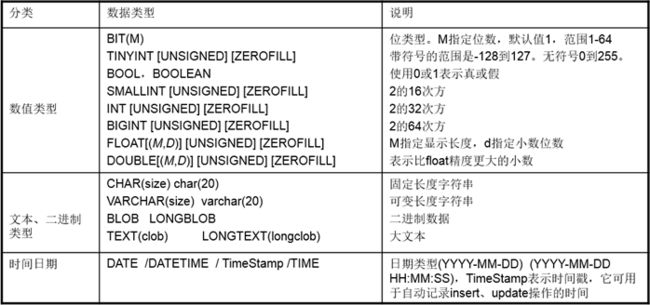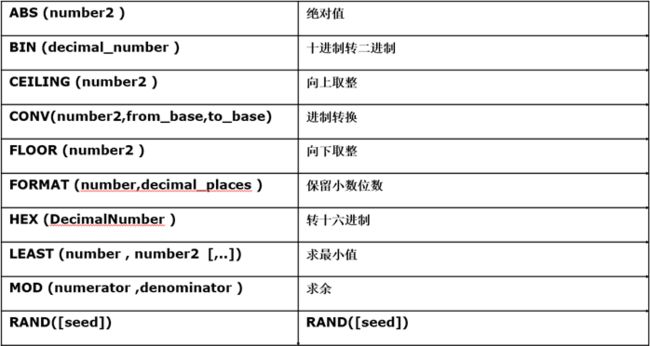环境:rhel7系统mysql
工具:secureCRT、UE
1.mysql的基本操作
1.1数据库CURD
对数据库进行增(create)、删(delete)、改(update)、查(Retrieve)操作。
1.1.1创建数据库
创建一个名称为mydb1的数据库。
create database mydb1;创建一个使用utf-8字符集的mydb2数据库。
create database mydb2 character set utf8;创建一个使用utf-8字符集,并带校对规则的mydb3数据库。会对存入的数据进行检查。
create database mydb3 character set utf8 collate utf8_general_ci;
1.1.2查看数据库
显示所有数据库
show databases;
显示创建数据库的语句信息
show create database mydb2;
“` ”(ESC键 下面的按键),表示反引号,默认情况下,反引号括起来的字符串,区分大小写。
show create database mydb1;
注意 :mysql默认语言集是latin1,每次在创建数据库的时候应指定字符集。Oracle是在安装时,即指定了字符集。
1.1.3修改数据库
修改mydb1的字符集为utf8(不能修改数据库名)
alter database mydb1 character set utf8;
1.1.4删除数据库
删除数据库mydb3
drop database mydb3;
1.2表的CURD
对表本身进行操作:创建,查看,修改,删除
1.2.1创建表
create table t1 (id int, name varchar(20))
但此时会报错误:ERROR 1046 (3D000): No database selected。注意,在mysql中对表操作前,必须先选择所使用的数据库。
use mydb2;
查看当前选择的数据库中的表:
show tables;
查看表结构:
desc t1;
在Mysql中显示多行数据应该在查询语句结尾处添加 \G来替换结束标记“;”
查看创建表的语法:
show create table t1; ENGINE=InnoDB 默认指定的存储引擎 innoDB。
- mysql中的数据类型
- bit 1位 可以指定位数,如:bit(3)
- int 2字节 可以指定最大位数,如:int<4> 最大为4位的整数
- float 2个字节 可以指定最大的位数和最大的小数位数,如:float<5,2> 最大为一个5位的数,小数位最多2位
- double 4个字节 可以指定最大的位数和最大的小数位数,如:float<6,4> 最大为一个6位的数,小数位最多4位
- char 必须指定字符数,如char(5) 为不可变字符 即使存储的内容为'ab',也是用5个字符的空间存储这个数据
- varchar 必须指定字符数,如varchar(5) 为可变字符 如果存储的内容为'ab',占用2个字符的空间;如果为'abc',则占用3个字符的空间
- text: 大文本(大字符串)
- blob:二进制大数据 如图片,音频文件,视频文件
- date: 日期 如:'1921-01-02'
- datetime: 日期+时间 如:'1921-01-02 12:23:43'
- timeStamp: 时间戳,自动赋值为当前日期时间
创建一个员工表:
create table employee(empno int, ename varchar(20), sal int);
1.2.2查看表
查看所有的表:
show tables;
查看指定表的创建语句
show create table employee; 注意,mysql表名称区分大小写
显示指定表的结构:
desc employee;
1.2.3修改表
更改表名:
rename table employee to worker;
增加一个字段:
alter table employee add column height double; (column关键字在Oracle中,添加则语法错误)
修改一个字段:
alter table employee modify column height float;
删除一个字段:
alter table employee drop column height;
修改表的字符集:
alter table employee character set gbk;
1.2.4删除表
删除employee表
drop table employee; (MySQL中不能使用purge,添加会出现语法错误)
1.3表数据的CURD
1.3.1create数据
创建一个员工表,新建employee表并向表中添加一些记录:
create table employee(
id int,
name varchar(20),
sex int,
birthday date,
salary double,
entry_date date,
resume text
);
insert into employee values(1,'张三',1,'1983-04-27',15000,'2012-06-24','一个大牛');
insert into employee(id,name,sex,birthday,salary,entry_date,resume) values(2,'李四',1,'1984-02-22',10000,'2012-07-24','一个中牛');
insert into employee(id,name,sex,birthday,salary,entry_date,resume) values(3,'王五',0,'1985-08-28',7000,'2012-08-24','一个小虾');
1.3.2update数据
将所有员工薪水都增加500元。
update employee set salary=salary+500;
将王五的员工薪水修改为10000元,resume改为也是一个中牛
update employee set salary=10000, resume='也是一个中牛' where name='王五';
1.3.3delete数据
删除表中姓名为王五的记录。
delete from employee where name='王五'; 【注意from不能省略】
删除表中所有记录。
delete from employee;
使用truncate删除表中记录。
truncate employee;--无条件 效率高
1.3.4Retrieve数据
select id, name as "名字", salary "月薪", salary*12 年薪 from employee where id >=2;
1.3.5综合案例
创建一个学生表,插入数据
create table student(
id int,
name varchar(20),
chinese int,
english int,
math int
);
insert into student(id,name,chinese,english,math) values(1, '范建',80,85,90);
insert into student(id,name,chinese,english,math) values(2,'罗况',90,95,95);
insert into student(id,name,chinese,english,math) values(3,'杜子腾',80,96,96);
insert into student(id,name,chinese,english,math) values(4,'范冰',81,97,85);
insert into student(id,name,chinese,english,math) values(5,'申晶冰',85,84,90);
insert into student(id,name,chinese,english,math) values(6,'郝丽海',92,85,87);
insert into student(id,name,chinese,english,math) values(7,'郭迪辉',75,81,80);
insert into student(id,name,chinese,english,math) values(8,'拎壶冲',77,80,79);
insert into student(id,name,chinese,english,math) values(9,'任我行',95,85,85);
insert into student(id,name,chinese,english,math) values(10,'史泰香',94,85,84);
---------------------------------------
基础SQL
查询表中所有学生的信息。
select * from student;
查询表中所有学生的姓名和对应的英语成绩。
select name,english from student;
过滤表中重复数据。
select english from student;
select DISTINCT english from student;
select DISTINCT english,name from student;
select english+chinese+math from student;
select english+chinese+math as 总分 from student;
select name,english+chinese+math as 总分 from student;
在所有学生英语分数上加10分特长分。
select name,english+10 from student;
统计每个学生的总分。
select english+chinese+math from student;
使用别名表示学生分数
select name,english+chinese+math as 总分 from student;
select name,english+chinese+math 总分 from student;
查询姓名为何东的学生成绩
select * from student where name='何东';
查询英语成绩大于90分的同学
select * from student where english>90;
查询总分大于250分的所有同学
select * from student where english+chinese+math>250;
查询英语分数在 85-95之间的同学。
select * from student where english>=85 and english<=95;
select * from student where english between 85 and 95;
查询数学分数为84,90,91的同学。
select * from student where math=84 or math=90 or math=91;
select * from student where math in(84,90,91);
查询所有姓何的学生成绩。
select * from student where name like '何%';
查询数学分>85,语文分>90的同学。
select * from student where math>85 and chinese>90;
对数学成绩排序后输出。
select * from student order by math;
对总分排序后输出,然后再按从高到低的顺序输出
select * from student order by math+chinese+english desc;
对姓何的学生成绩排序输出
select * from student where name like '何%' order by math+chinese+english desc;
select name, math+chinese+english from student where name like '何%' order by math+chinese+english desc;
统计一个班级共有多少学生?
select count(*) from student;
统计数学成绩大于90的学生有多少个?
select count(*) from student where math>90;
统计总分大于250的人数有多少?
select count(*) from student where math+chinese+english>250;
统计一个班级数学总成绩?
select sum(math) from student;
统计一个班级语文、英语、数学各科的总成绩
select sum(math), sum(chinese), sum(english) from student;
统计一个班级语文、英语、数学的成绩总和
select sum(math+chinese+english)from student;
select sum(math)+sum(chinese)+sum(english) from student;
求一个班级数学平均分?
select avg(math) from student;
求一个班级总分平均分
select avg(math+chinese+english)from student;
select avg(math)+avg(chinese)+avg(english) from student;
求班级最高分和最低分
select max(math+chinese+english),min(math+chinese+english) from student;
--分组数据
为学生表,增加一个班级列,练习分组查询。
alter table student add column class_id int;
注意语法:Oracle中不能有“column”关键字,MySQL中有没有“column”都可以执行。
--更新表:
update student set class_id=1 where id<=5;
update student set class_id=2 where id>5;
(update student set class_id=2 where id between 6 and 10;)
查出各个班的总分,最高分。
求各个班级 英语的平均分:
select classid, avg(english)
from student
group by class_id
如根据组函数的语法要求,将select后增加name列,而不加至group by 之后:
select name, classid, avg(english)
from student
group by classid;
会发现MySQL检查不出错误。相比Oracle数据库,MySQL分组检查不严格。
select sum(math+chinese+english),max(math+chinese+english) from student group by class_id;
查询出班级总分大于1300分的班级ID
select class_id from student group by class_id having sum(math+chinese+english)>1300;
select class_id from student where sum(math+chinese+english)>1300 group by class_id ;
对于组函数的应用与Oracle类似,可以应用于Having中,但不能用于where子句中。
1.4日期时间函数
MySQL里面时间分为三类:时间、日期、时间戳(含有时分秒的sysdate)。
如执行:select now(), year(now()) 年, month(now()) 月, day(now()) 日, date(now());
select CURRENT_DATE() , CURRENT_TIME(), CURRENT_TIMESTAMP() from dual;
昨天、今天、明天:
select now()-1 昨天, now() 今天, now()+1 明天 from dual;
发现与Oracle中的日期加减操作有所不同。
select date_add(now(), INTERVAL 2 year) from dual; //增加两年
select date_add(now(), INTERVAL -1 day) 昨天, now() 今天, date_add(now(), INTERVAL +1 day) 明天;
5.字符串相关函数
select concat('hello ', 'mysql ', 'haha ', 'hehe ') from dual;
Oracle默认只能拼两个,如需多个拼接可以使用嵌套。
select 'hello ' || 'mysql ' from dual; ‘||’ 在 MySQL不可以使用。
日期转字符串:
在MySQL中没有to_date函数,进行日期转换需使用date_format()来代替。
select date_format('2013-5-11', 'yyyy-mm-dd') from dual; 在Oracle中的‘yyyy-mm-dd’MySQL下不支持。
select date_format(now(), '%Y-%m-%d') from dual; y和Y不一样。
select date_format(now(), '%Y-%c-%d %h:%i:%s') from dual; c和m、M不一样
所以yyyy-mm-dd hh24:mi:ss格式在MySQL中对应'%Y-%c-%d %h:%i:%s'
字符串转日期:
select str_to_date('2013-6-04 05:14:15' , '%Y-%c-%d %h:%i:%s') from dual;
6.数学相关函数
7.多表查询
创建多表查询案例——MySQL建表_仿照oracle建表脚本.sql 【mysql> source 绝对路径/脚本名】
Oracle中连接方法:
- 等值连接
- 不等值连接
- 外连接
- 自连接
MySQL 使用SQL99标准的连接查询(JOIN..ON..)
7.1交叉连接
叉集,即笛卡尔集
select e.*, d.*
from emp e cross join dept d
无连接条件
7.2内连接(等值链接)
只返回满足连接条件的数据(两边都有的才显示)。 对应等值连接
select e.*, d.*
from emp e inner join dept d
on e.deptno=d.deptno
也可以省略inner关键字。
对应Oracle写法:
select e.*, d.*
from emp e , dept d
where e.deptno=d.deptno
7.3左外连接
左边有值才显示。
select e.*, d.*
from emp e left outer join dept d
on e.deptno=d.deptno
也可以省略outer关键字
7.4 右外连接
右边边有值才显示。
select e.*, d.*
from emp e right outer join dept d
on e.deptno=d.deptno
也可以省略outer关键字
7.5 满外联接
任一边有值就会显示。
select e.*, d.*
from emp e full outer join dept d
on e.deptno=d.deptno
也可以省略outer关键字
7.6 对比练习
题目1:
查询员工信息,员工号,姓名,月薪,部门名称
select ...
from emp e, dept d
where e.deptno = d.deptno;
Oracle实现:
select e.deptno, e.ename, e.sal, d.dname
from emp e, dept d
where e.deptno = d.deptno
SQL99实现:
select e.deptno, e.ename, e.sal, d.dname
from emp e inner join dept d
on e.deptno = d.deptno
对比记忆规律:
“,” → [inner] join
where → on
对比结论:mysql能识别Oracle中使用 = 连接的书写方法。
题目2:
统计各个部门员工总人数
分析:部门包括10/20/30 → 分组
各部门人数 → 多表
select ...
from emp e, dept d
where d.deptno = e.deptno
group by ...
(注意:group by后面出现的子集应在select下进行检索)
实现为:
select d.deptno, d.dname,
count(e.deptno)
from dept d, emp e
where d.deptno = e.deptno
group by d.deptno, d.dname
查询发现没有40号部门。此时应使用外链接保存一侧结果。
oracle实现:
select d.deptno, d.dname ,
count(e.deptno)
from dept d, emp e
where d.deptno = e.deptno (+)
group by d.deptno, d.dname
SQL99实现:
select d.deptno, d.dname ,
count(e.deptno)
from dept d left outer join emp e
on d.deptno = e.deptno
group by d.deptno, d.dname
对比记忆规律:
“,”→ left/right outer join
where → on
结论:oracle的语法(+) mysql不支持
7.7 自连接
查询员工、老板信息,显示: xxx的老板是xxx
分析:将一张emp表当成两张表看待:员工表、老板表(员工表的老板 是 老板表的员工)
1. 先按照oracle语法写
select e.ename, b.ename
from emp e, emp b
where e.mgr = b.empno
2. 完善显示格式concat
select concat( e.ename, ' 的老板是 ', b.ename )
from emp e, emp b
where e.mgr = b.empno
3. 显示king的老板
select concat( e.ename, ' 的老板是 ', b.ename )
from emp e, emp b
where e.mgr = b.empno (+)
4. 改用MySQL支持的SQL99语法
select concat( e.ename, ' 的老板是 ', b.ename )
from emp e left outer join emp b
on e.mgr = b.empno ;
5. 滤空修正nvl
select concat( e.ename, ' 的老板是 ', nvl(b.ename, '他自己' ) )
from emp e left outer join emp b
on e.mgr = b.empno ;
结论 nvl 在mysql下不能使用: ERROR 1305 (42000): FUNCTION mydb61.nvl does not exist
6. 滤空修正 ifnull
select concat( e.ename, ' 的老板是 ', ifnull(b.ename, '他自己' ) )
from emp e left outer join emp b
on e.mgr = b.empno ;
注意:
Oracle中有一个通用函数,与MYSQL中的ifnull函数名字相近:
nullif:如nullif(a, b) 当 a = b 时返回null, 不相等的时候返回a值。nullif('L9,999.99', 'L9,999.99')
mysql中nullif()函数也存在。
3.8 表的约束
- 定义主键约束 primary key: 不允许为空,不允许重复
- 定义主键自动增长 auto_increment
- 定义唯一约束 unique
- 定义非空约束 not null
- 定义外键约束 constraint ordersid_FK foreign key(ordersid) references orders(id)
- 删除主键:alter table tablename drop primary key ;
MySQL中约束举例:
create table myclass (
id INT(11) primary key auto_increment,
name varchar(20) unique
);
create table student (
id INT(11) primary key auto_increment,
name varchar(20) unique,
passwd varchar(15) not null,
classid INT(11),
constraint stu_classid_FK foreign key(classid) references myclass(id)
);
check约束在MySQL中语法保留,但没有效果。





